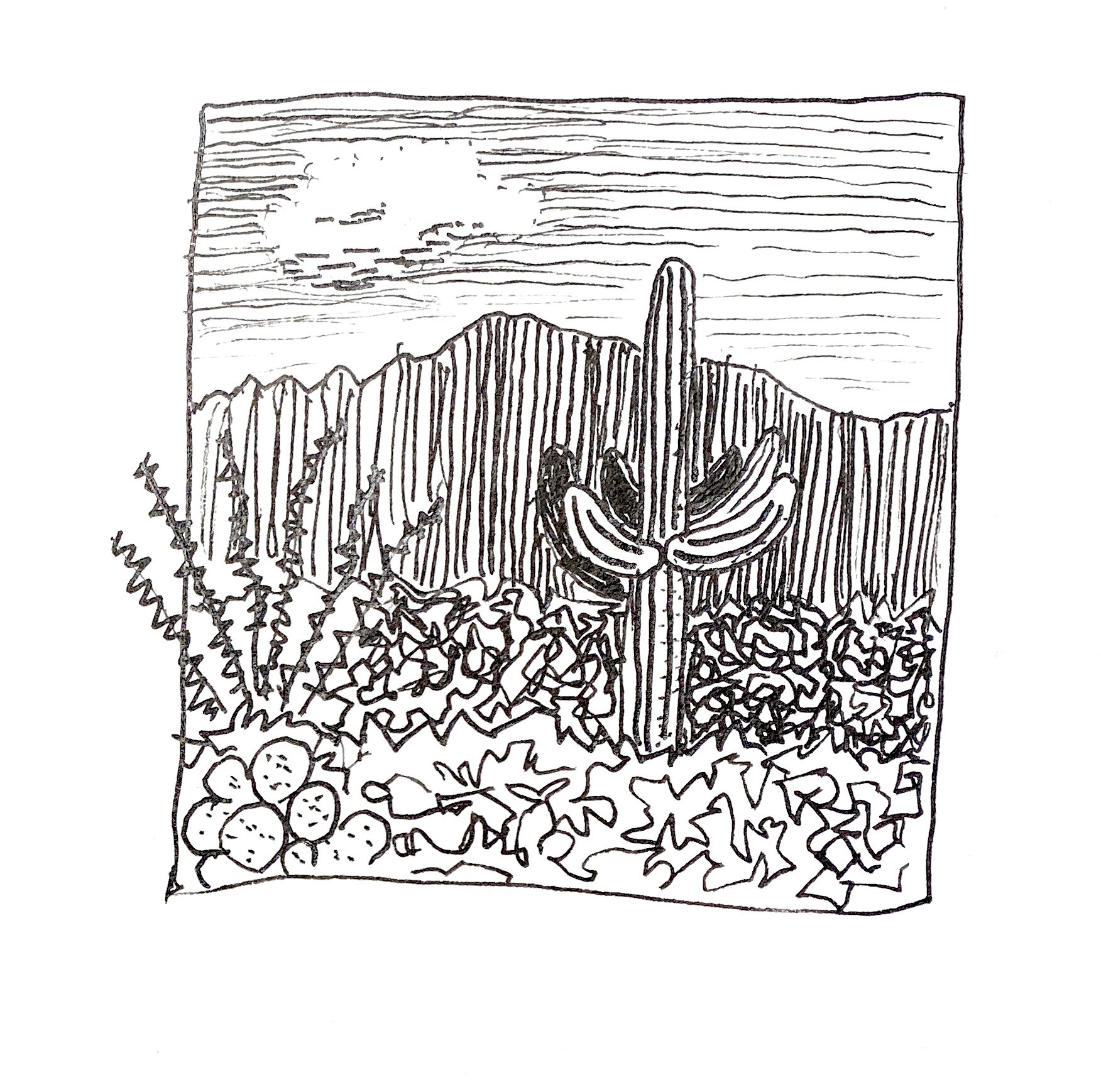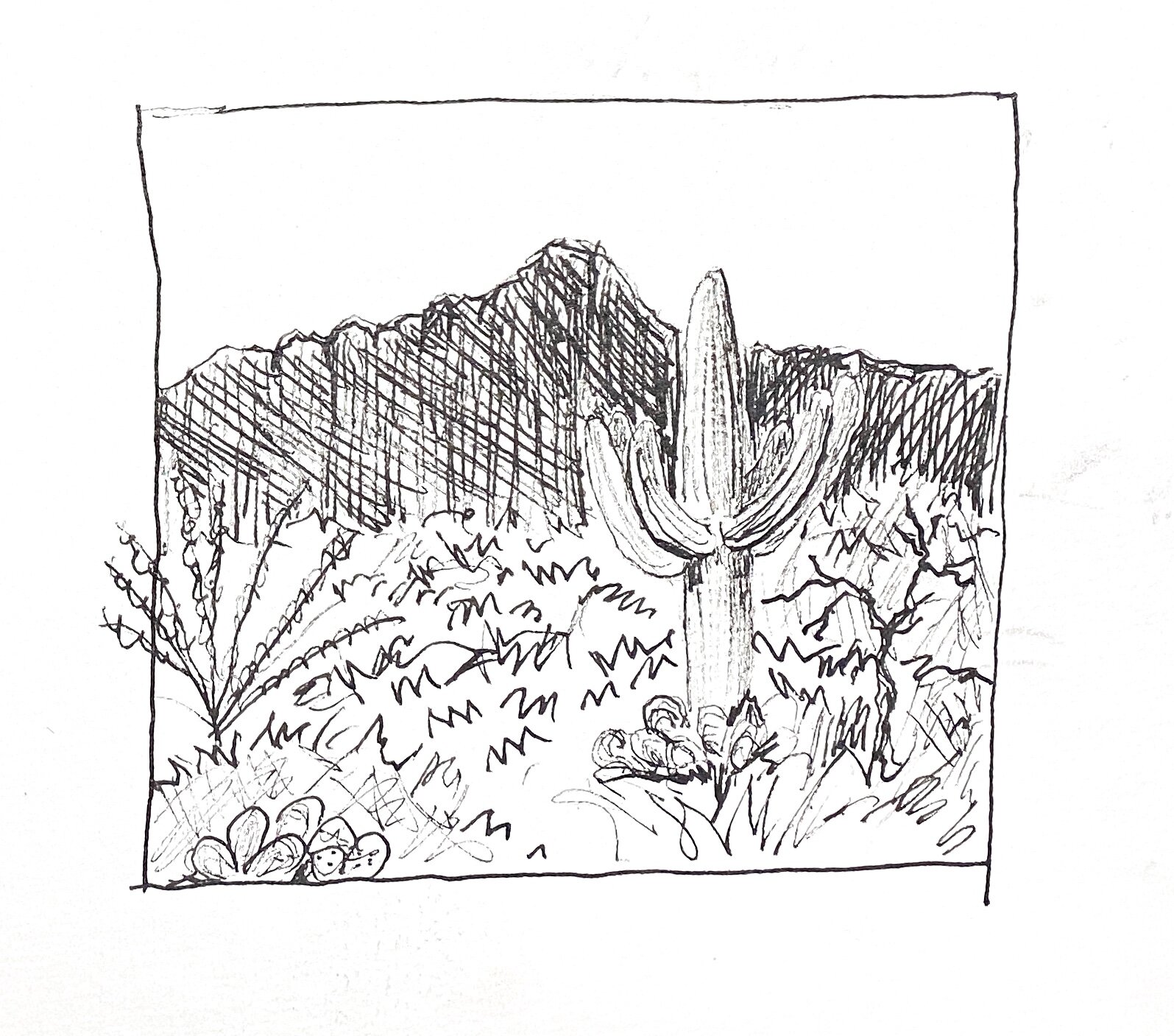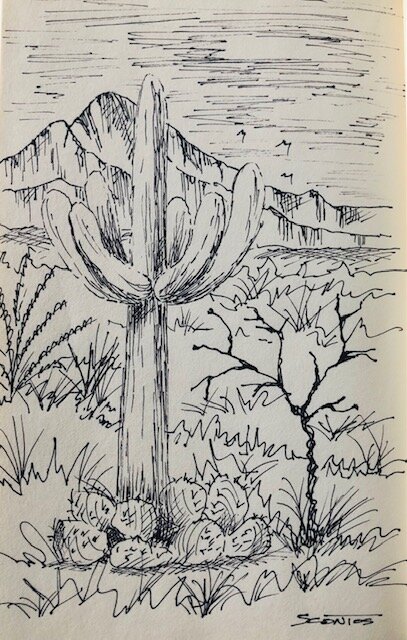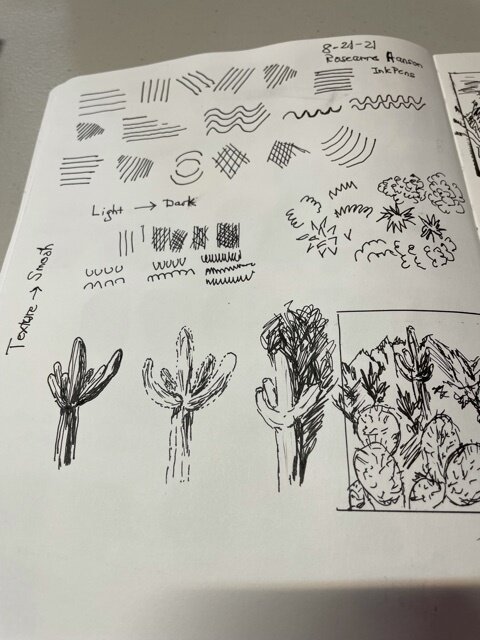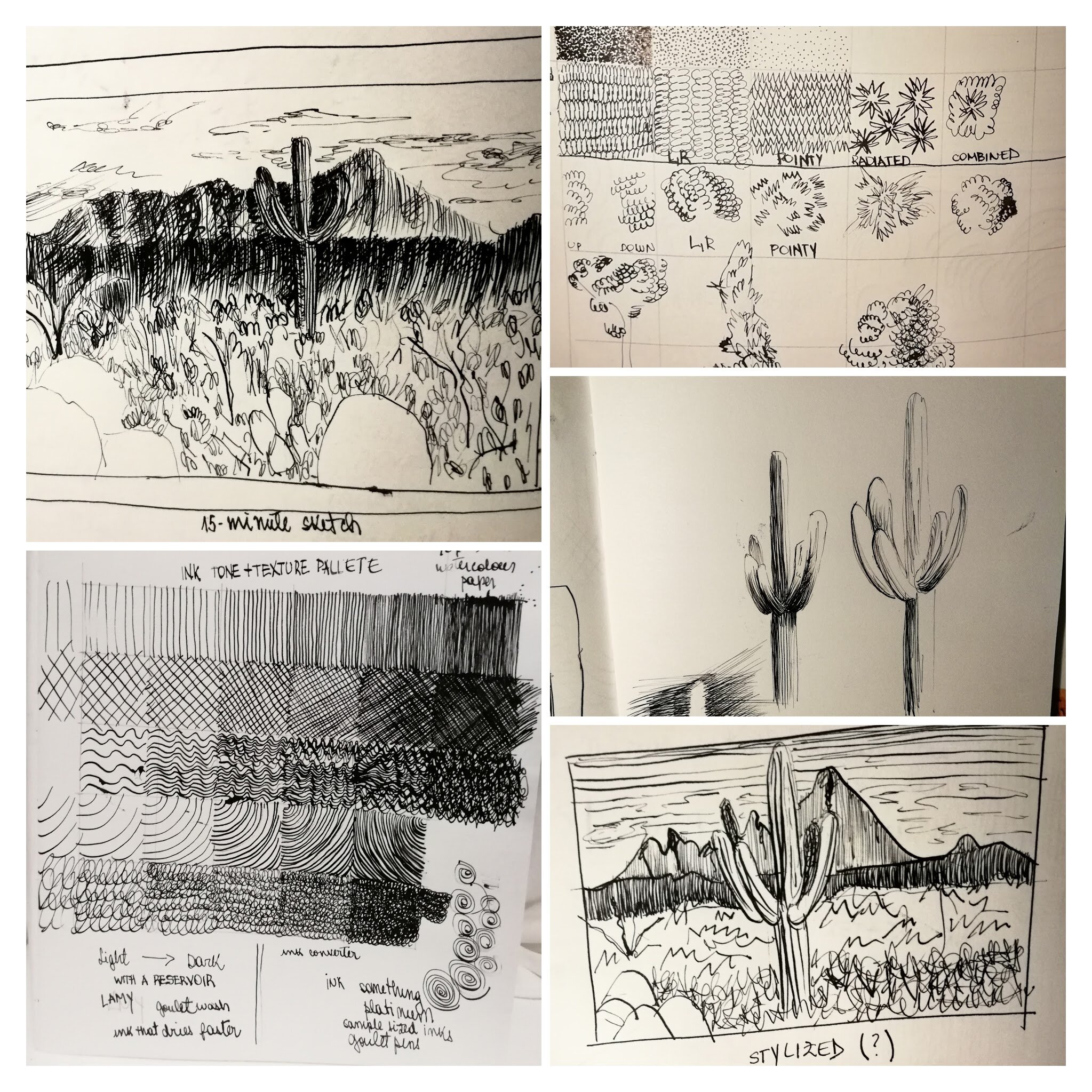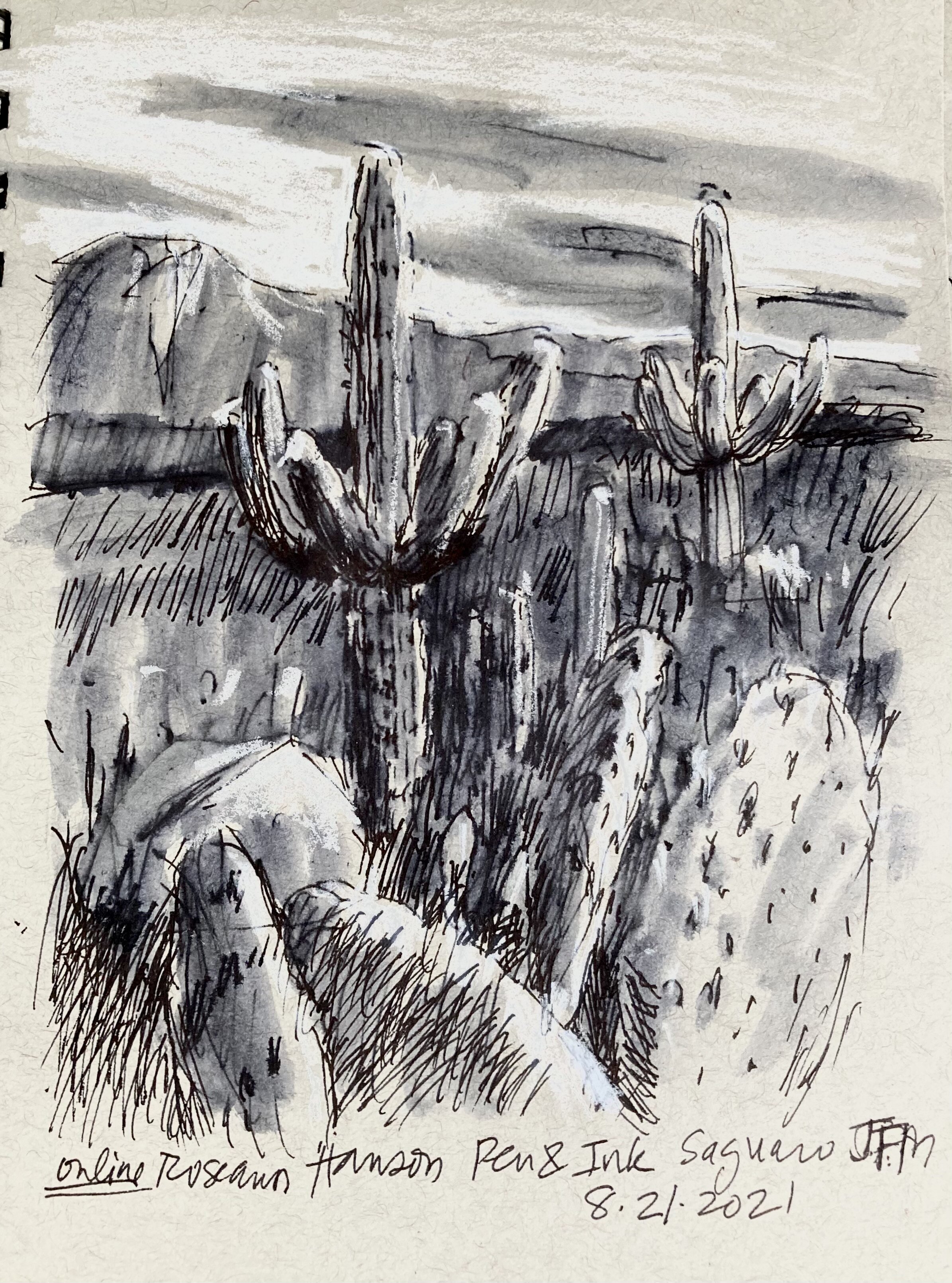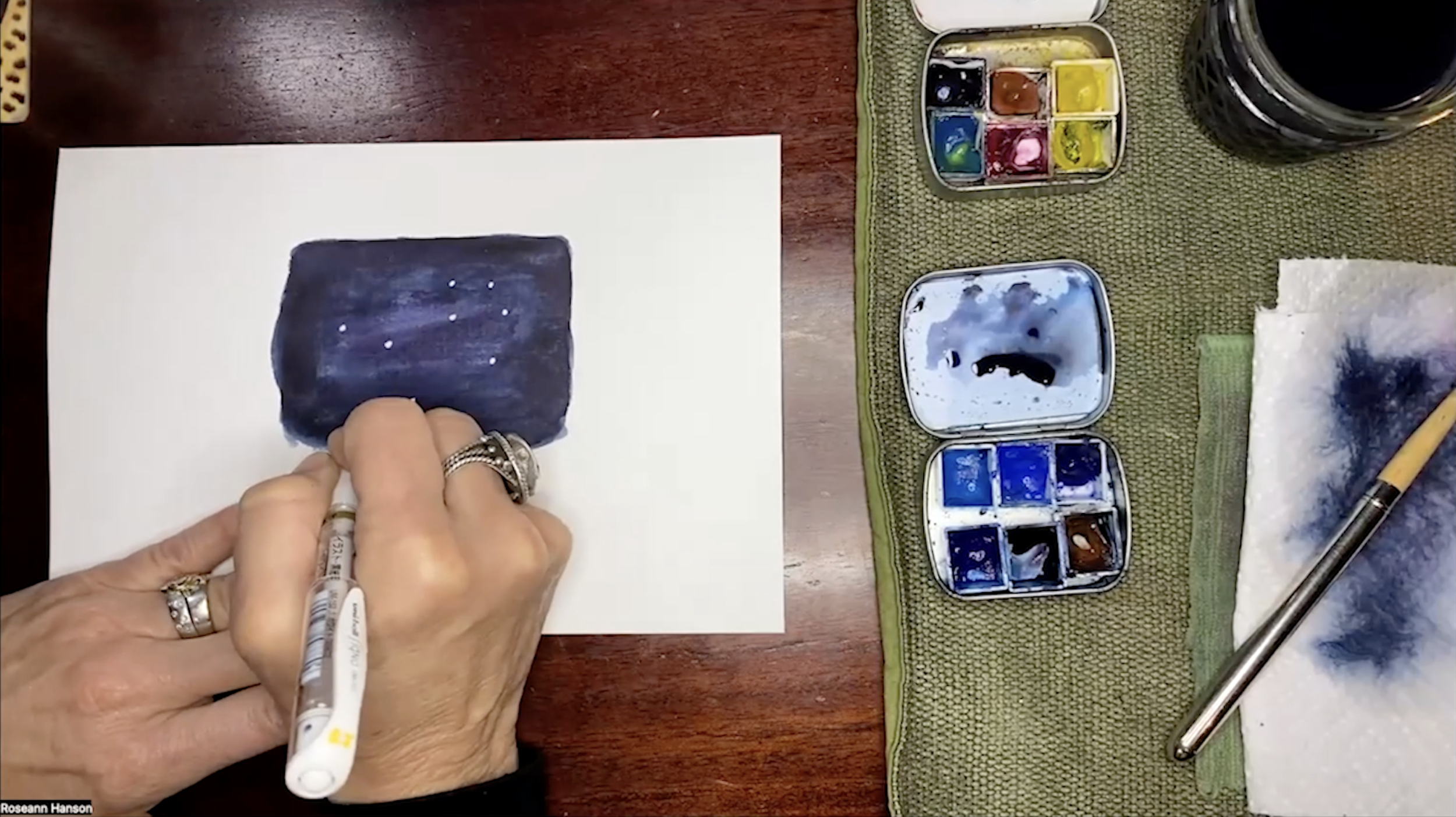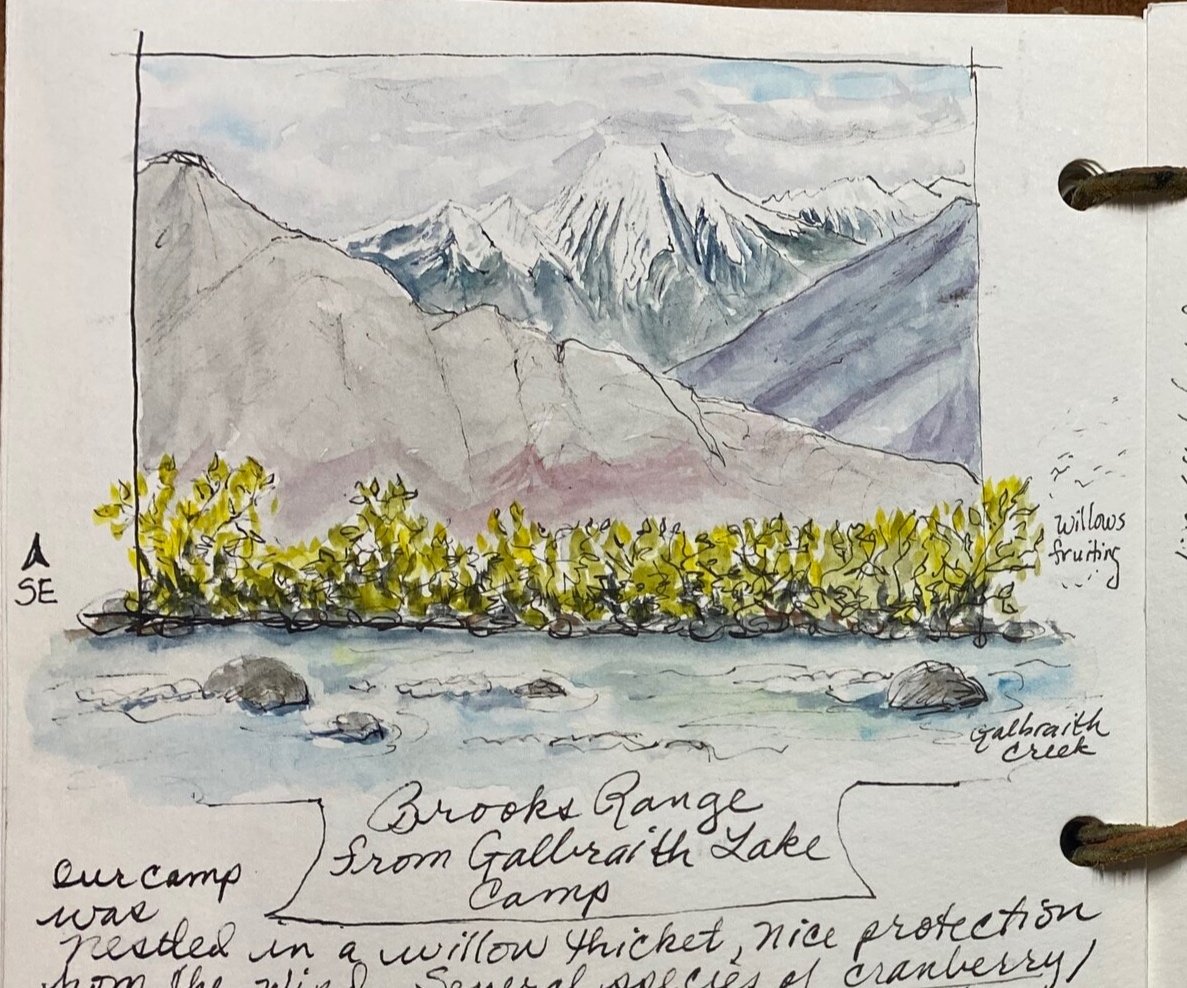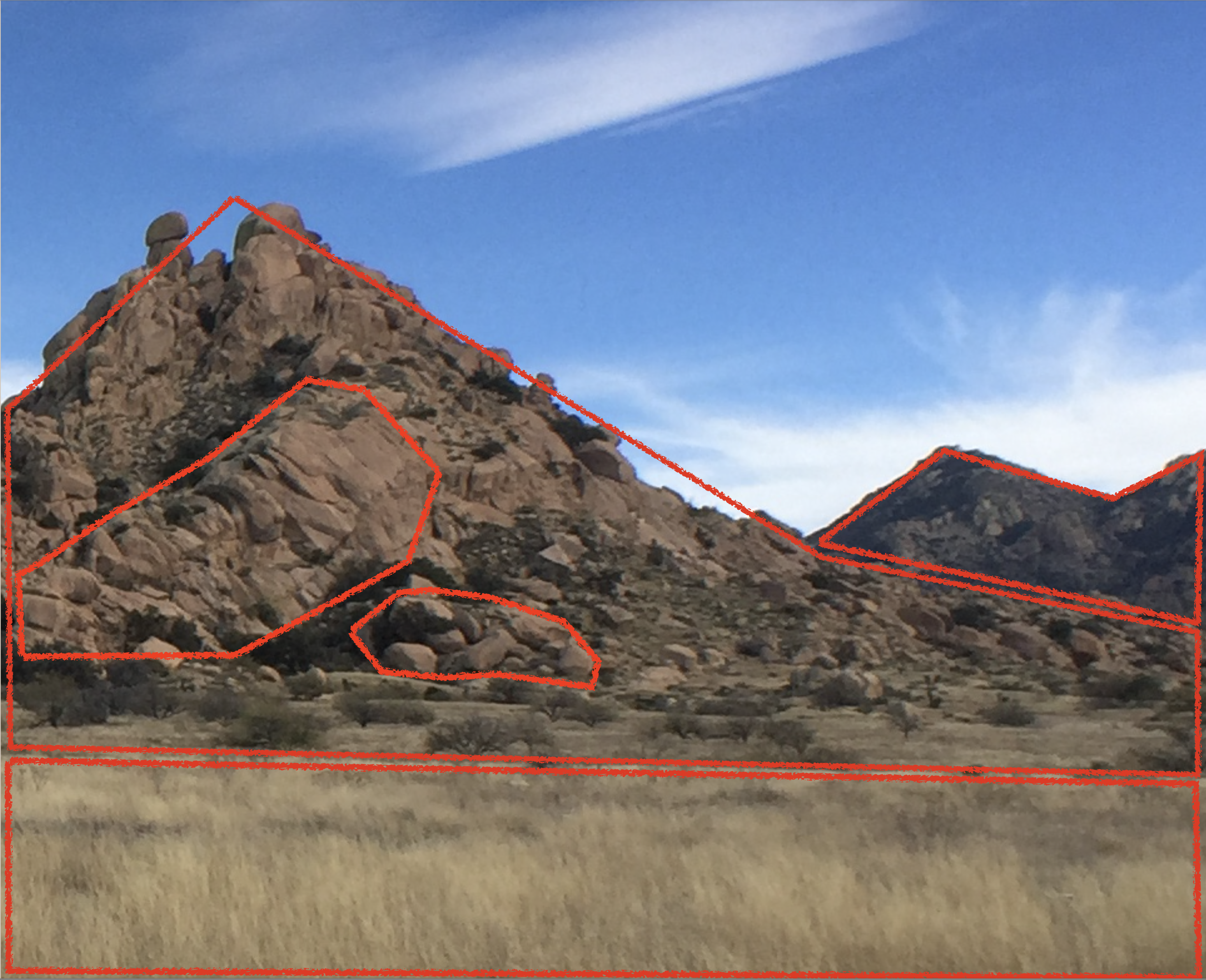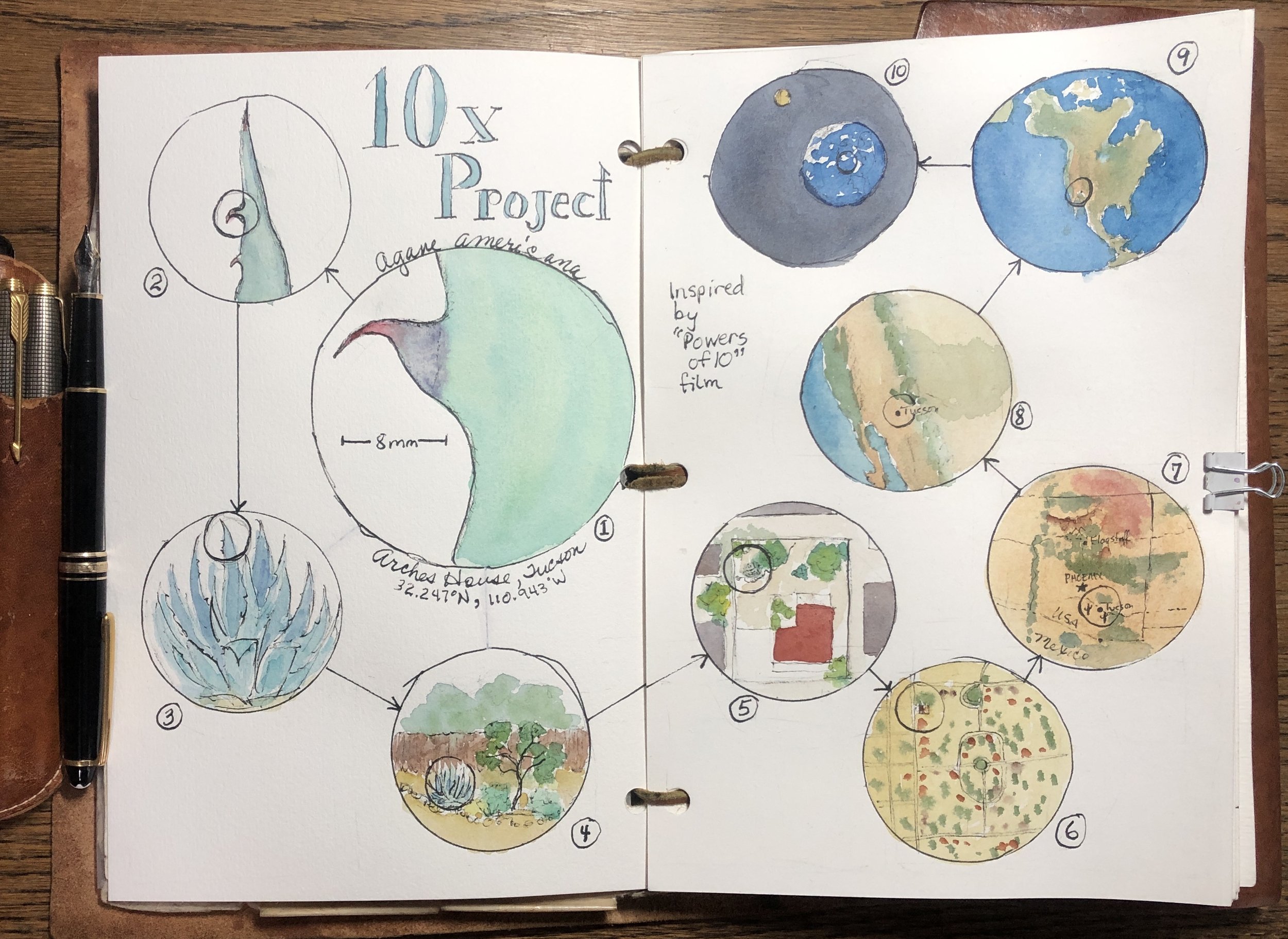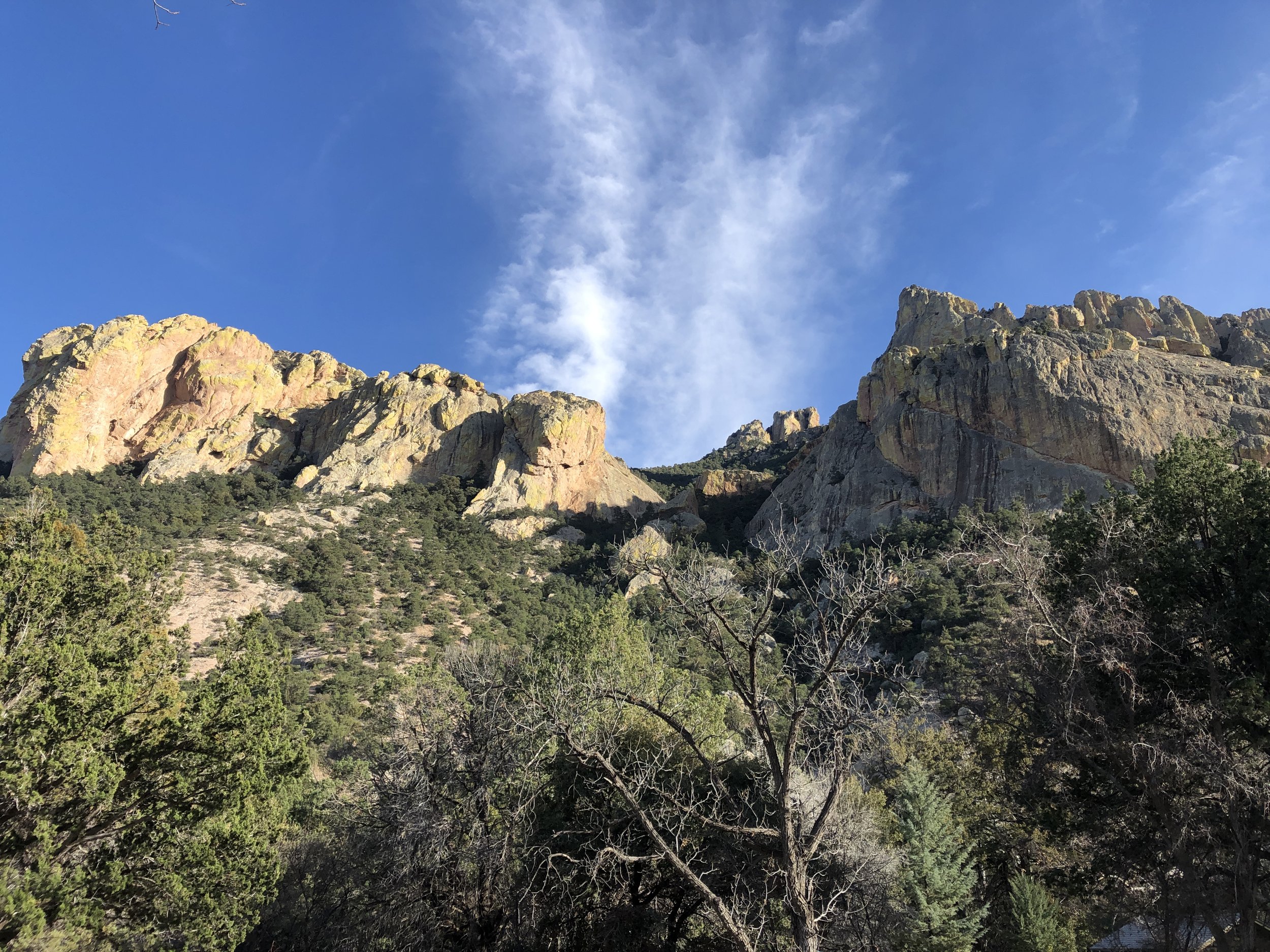How to Add Ephemera to Your Journal
How do you incorporate ephemera (maps, postcards, stamps, etc.) into your journal if you didn’t plan room for them, but you want to be sure you keep them secured for future access? 🗺🖼📑
I thought about stitching a pocket (made from a scrap of watercolor paper) onto one of the pages from Point Reyes, CA, but that would permanently cover part of my entry. Instead, I opted for insets, so the ephemera are removable yet secured while in the journal. Here’s the quick how-to:
Decide where you want the ephemera, then mark three corners with pencil (check the backside so you aren’t cutting across something you really like!).
I keep a small scalpel in my field bag, and a scrap of cardboard in the back of my journal. Slice across the diagonal on three corners, placing the cardboard underneath before you do so (don’t get too excited and forget!).
Slide in your ephemera and admire!







Field Arts Workshop: Creative Night Skies (Full Class)
How do you journal night skies? It's always been a love-hate thing for me—I love tracking the stars and planets and finding constellations, but depicting them in journals can be challenging!
In this free online workshop, I demonstrate four different approaches:
Pre-painted watercolor skies on which you can add sky components live or after a sky-viewing telescope session (a technique inspired by Alaska artist Kristin Link);
Making a cutaway peek-a-boo window showing day-and-night;
Using Sharpies and white, silver, or other metallic pens and pencils; and
Using black paper and white, silver, or other metallic pens, pencils, and paint.
WHAT YOU WILL NEED:
Journal with or sheets of watercolor paper;
Paint colors: Indigo, Pthalo Blue (Green Shade), Quinacridone Rose or similar, Burnt Sienna (mine are Daniel Smith but any brand will do);
Hair dryer;
White gel pen (the best is Uniball Signo;
White and red colored pencils;
For fun if you have them: metallic paints or pens and pencils;
Black Sharpie;
Black paper.
Here is a link to a static post with photos and more instructions:
https://www.exploringoverland.com/constantapprentice/2023/4/10/journaling-night-skies
Attendees’ Pages
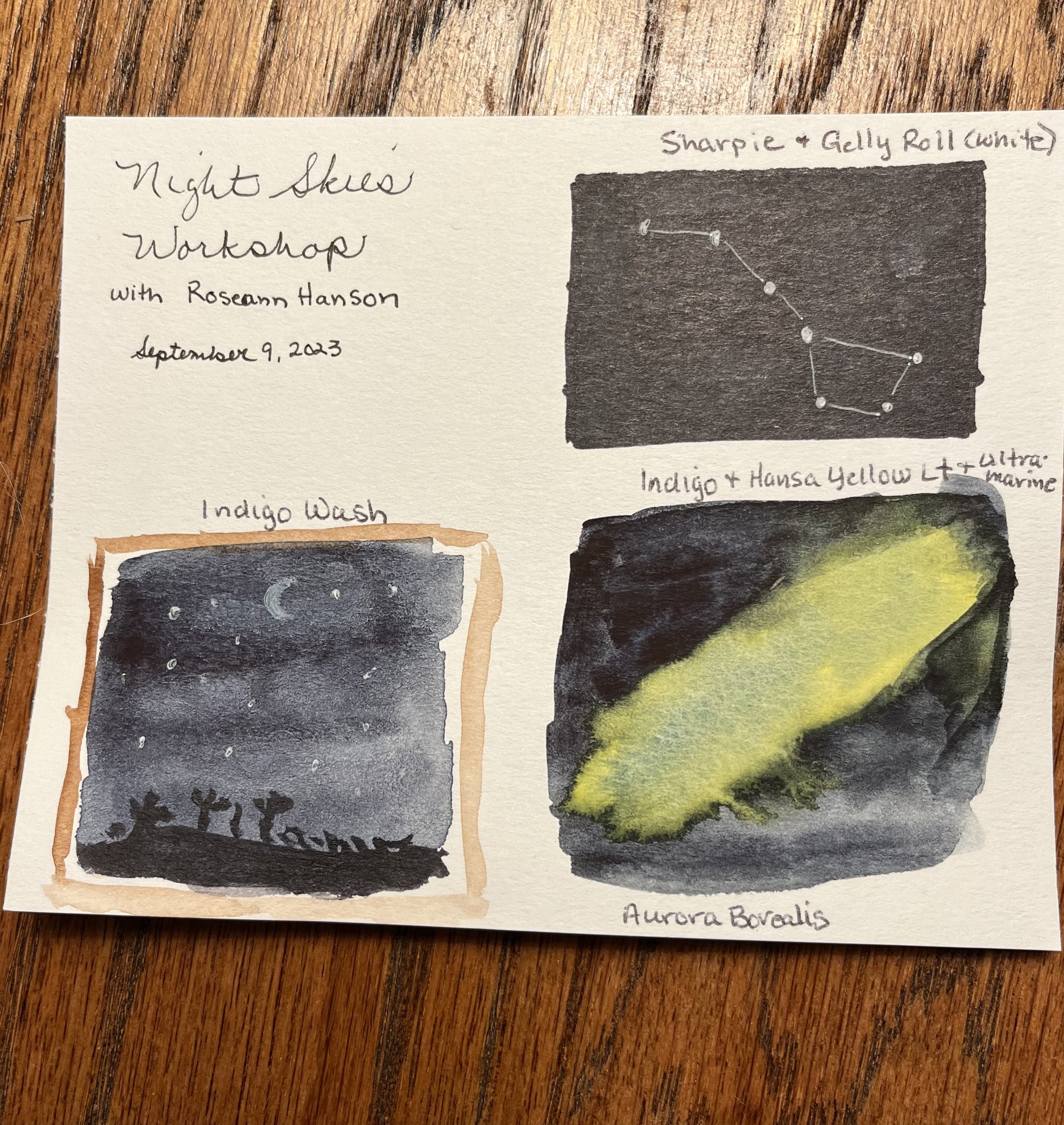

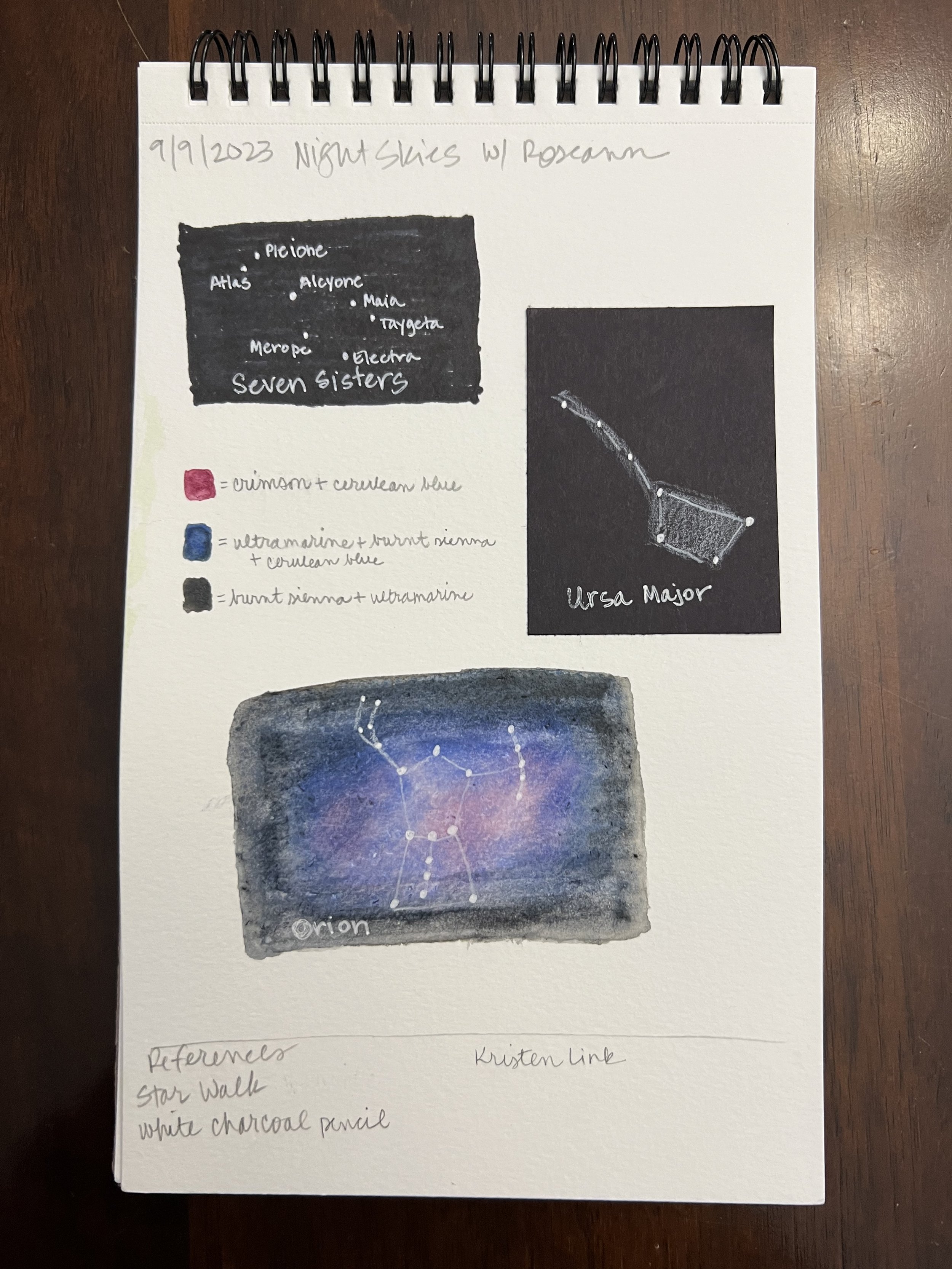
Field Arts Workshop: Landscapitos! Little drawings, big impact
Adding small landscape drawings and paintings to your journals creates a wonderful sense of place, greatly enhancing your pages. John Muir Laws calls them “landscapitos!” Don’t be intimidated! These are fast, fun, and addictive.
I’ll take you on two or three explorations using my Virtual Field Trip technology; I’ll walk you through how I choose a scene to sketch, how I “edit” down the view so I’m not overwhelmed, and how I quickly map out the drawing using big shapes. Then we’ll add some beautiful watercolor.
Have your journal and pencil or pen with waterproof ink handy, along with your favorite watercolors. Have you seen my new Earth Palette? These are especially fun paints for landscapitos.
Length: 1 hour, 30 minutes
Resources from the Workshop
CHAT transcript — click > HERE <
Information and links from the workshop:
My favorite paints: Minimalist = a true primary triad (cyan, magenta, yellow) plus two wild-card colors for making browns and black. I like Daniel Smith Manganese Blue, Quinacridone Rose, and Aureolin Yellow, plus Burnt Sienna and Indanthrone Blue. Or, love Greenleaf & Blueberry’s Cyan, Magenta and Yellow, and their Red Ochre and Mayan Blue 2. https://www.exploringoverland.com/academy#color
https://www.exploringoverland.com/shop/minimalist-paint-tins-2-sizes-with-or-without-paint-samples
My notebook: Handmade leather, tutorial here: https://www.exploringoverland.com/field-arts-tutorials-list/2020/8/18/adding-pages-to-my-handmade-leather-journal
Grids: https://www.dickblick.com/products/compose-it-grids/
Perspex Palette: https://www.exploringoverland.com/shop/clear-perspex-palette-with-magnet-strip
Aspect Ratios information:
ASPECT RATIO = SHORTER EDGE ÷ LONGER EDGE
3 ÷ 3.75 = 0.8
4 ÷ 5 = 0.8
Click on image at right to enlarge:
White painter’s tape or washi tape:
https://www.dickblick.com/products/blick-artist-tape/
https://www.amazon.com/MT-Solids-Masking-Tape-MT01P208/dp/B00DHZP2FS/
mt Washi tape can be found with a cute little cutter.
Field Trip: Southern Colorado
https://360exploring.s3-us-west-1.amazonaws.com/Mountains-Mesas-2020/output/index.html
Field Trip: Kenai Peninsula, Grewlingk Glacier (we didn’t have time for this one, but if you practice landscapitos here, please credit Kim McNett as photographer)
https://360exploring.s3.us-west-1.amazonaws.com/Alaska/output/index.html
Landscapitos from the Workshop
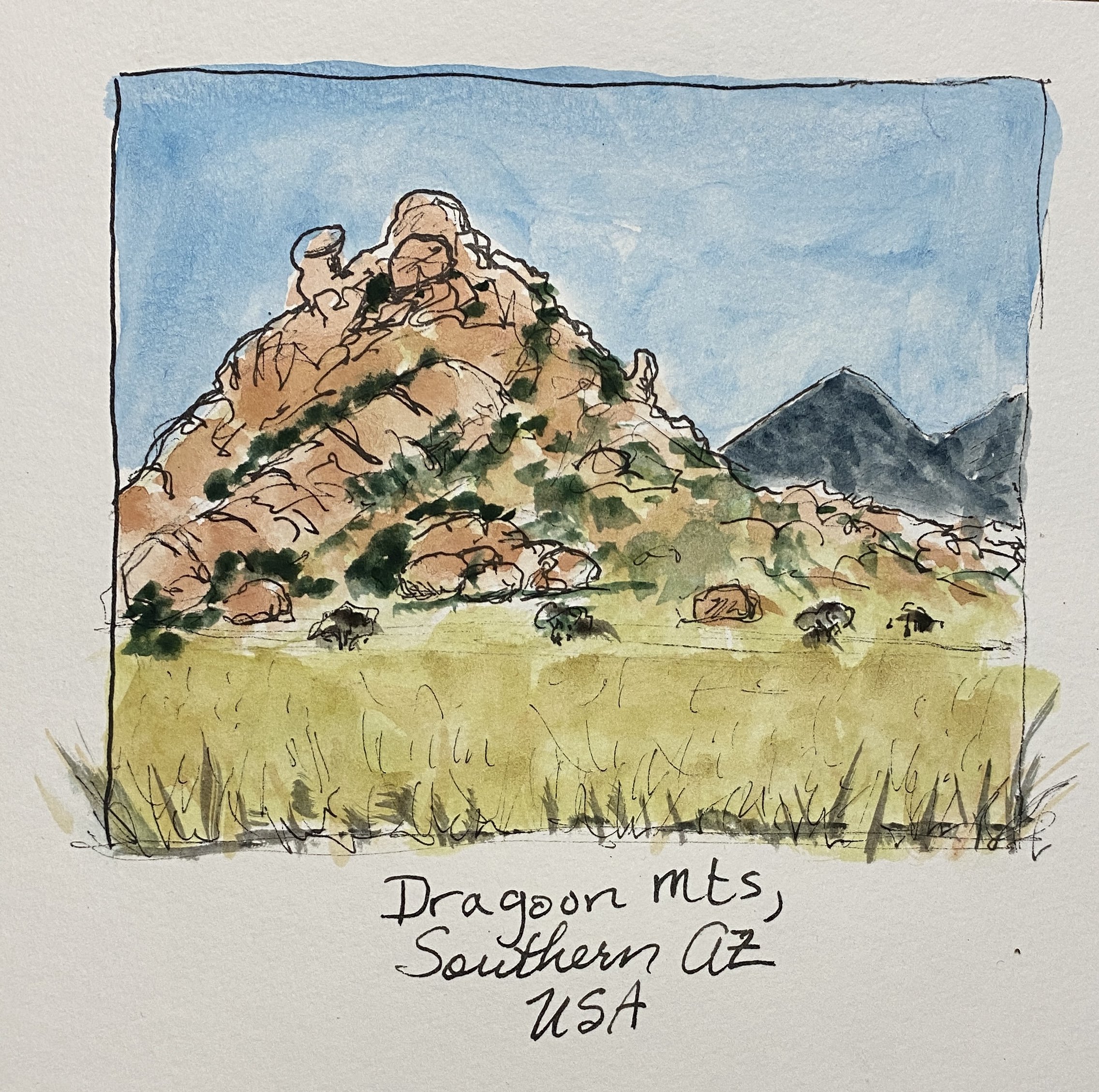

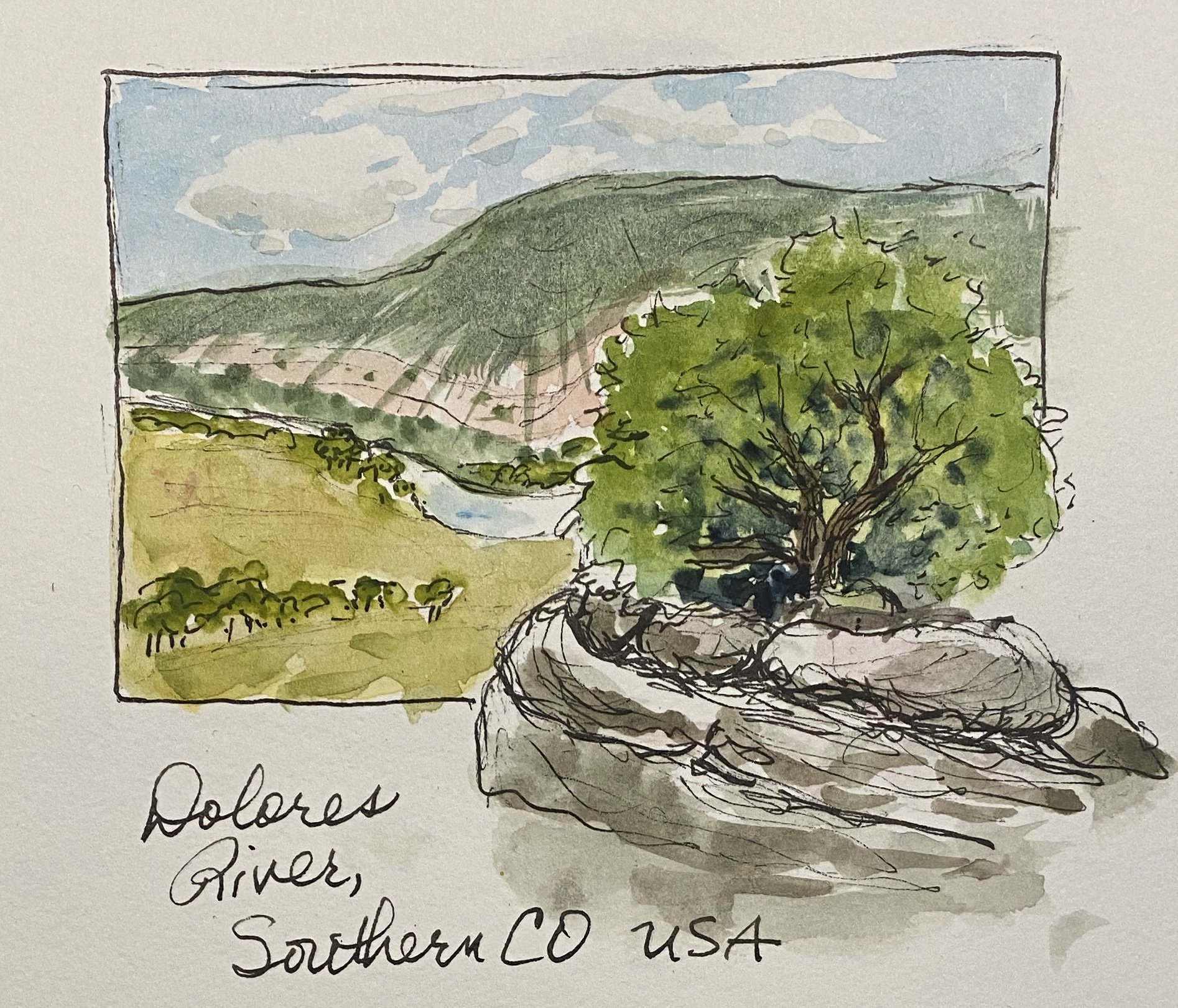
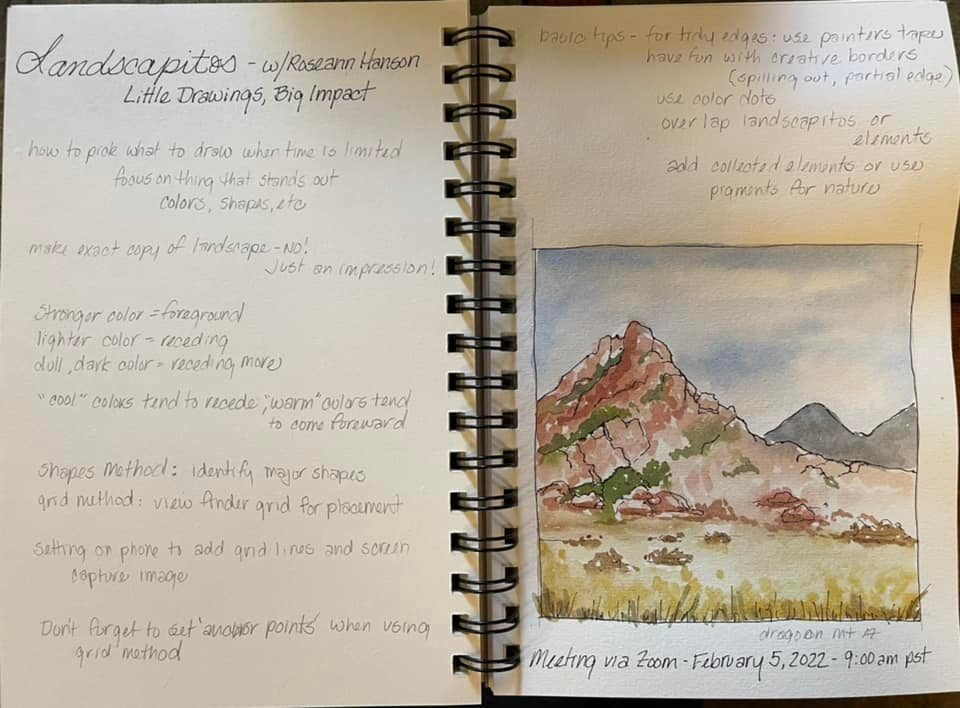
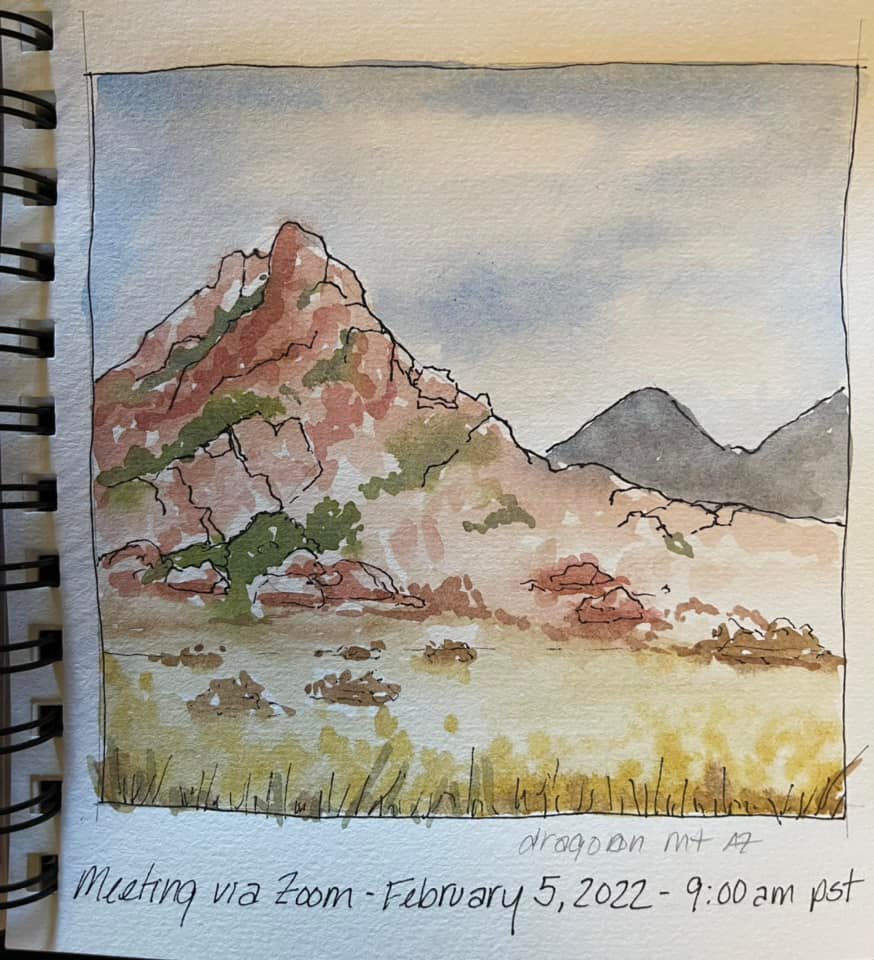
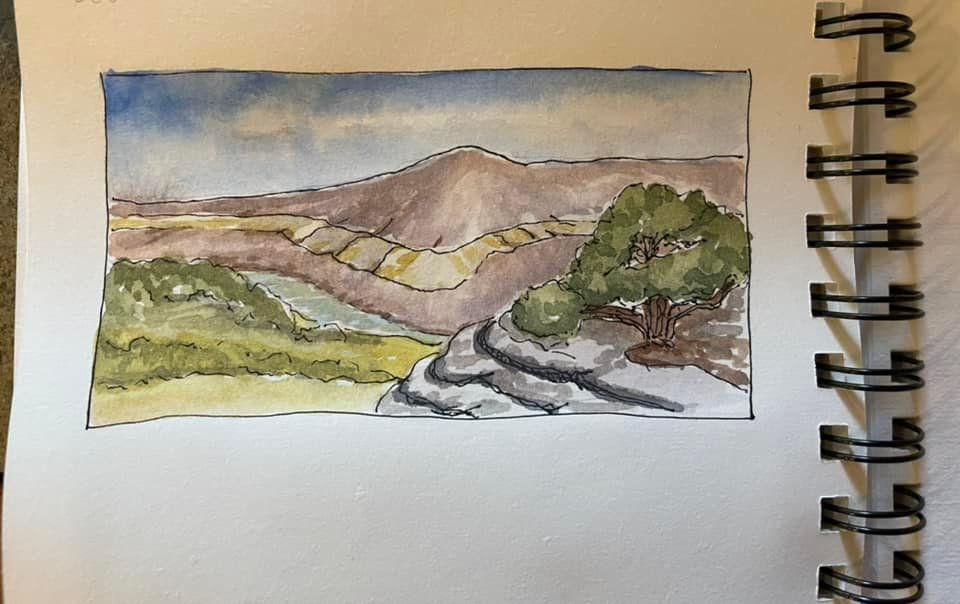

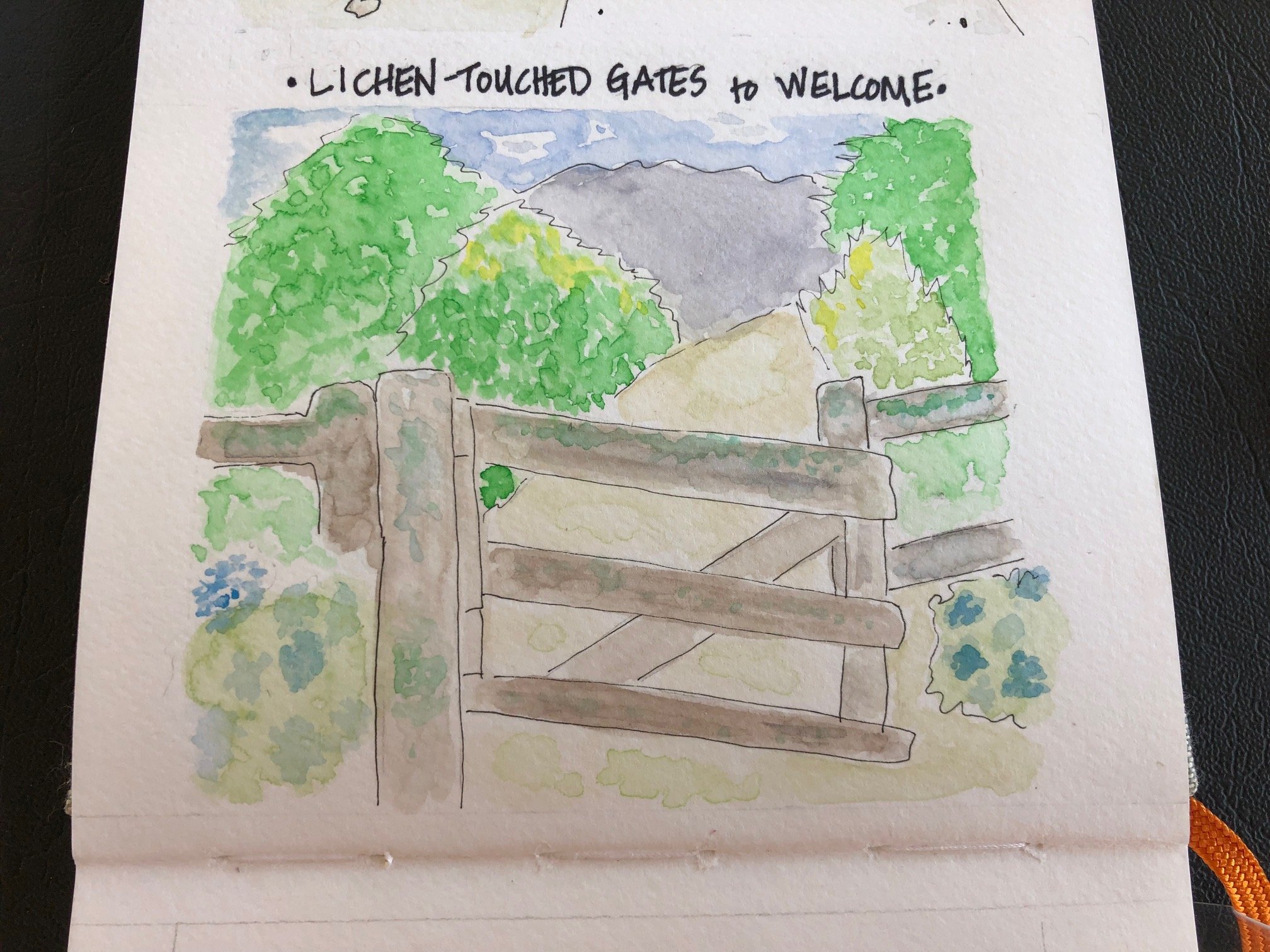

Practice isolating big shapes — Dragoon Mountains, Southern Arizona, USA
From the Virtual Field Trip “Mountains and Mesas” here: https://360exploring.s3-us-west-1.amazonaws.com/Mountains-Mesas-2020/output/index.html
This is the Dolores River, southern Colorado, USA.
Field Arts Workshop: Layout Strategies for Beautiful (Organic) Pages
Tennis star Arthur Ashe famously said: “There is a syndrome in sports called ‘paralysis by analysis.’” The same is true for art. A study published in the Journal of Neuroscience found that the prefrontal cortex—which is housed in the cerebrum—is the part of the brain responsible for planning, executive function, and working memory. Further, the findings showed that overactivity in the prefrontal cortex can interfere with brain processes necessary to perform fluidly; simply put, this can cause people to “choke,” whether you are an athlete or an artist.
This fun and inspiring workshop is going to focus on how we “loosen up” and let go of Type-A-style planning so that our pages become beautiful in an organic way, enhanced by our science-oriented data—which is the most beautiful thing of all.
We’ll also have some fun with a few tools and tricks: a caliper to measure proportions (which happen to coincide with the “Golden Mean” . . . don’t worry we’ll cover that, too!) and a fun protractor for making perfect circles.
Length: 2 hours
Resources from the Workshop
Handout with images, tips and links: https://www.dropbox.com/s/swadhrq8gdms0mg/Organic%20Page%20Layout%20-%20Final%20PDF%20Roseann%20Hanson.pdf?dl=0
CHAT transcript — click > HERE <
Click to initiate download of a PDF of the workshop presentation (50mb file): https://www.dropbox.com/s/cwglitp4269b6n0/Organic%20Layout%2012-04-2021.pdf?dl=0
Links from the workshop:
Virtual Field Trip to Arctic Alaska: https://360exploring.s3.us-west-1.amazonaws.com/Arctic+Alaska/output/index.html
Helix Round Protractor:
From the Field Arts shop, in the Discovery Kit: https://www.exploringoverland.com/field-arts-shop
From Amazon, search for “Helix Round Protractor”
Screen shot of the Virtual Field Trip to Arctic Alaska by Roseann Hanson
Layout sketch idea #1
Layout sketch idea #2
Field Arts Workshop: Ancient Ochres
Human use of pigments to express ourselves may be—literally—a watershed moment in evolutionary time. Perhaps among the first to be used were iron oxides (ochres) such as at France’s famous Lascaux. Archaeologist Tammy Hodgskiss wrote: “People may say ochre is the earliest form of art and symbolism, but there’s more to it. Ochre shows how our brains were developing, and that we were using our environment. It bridges the divide between art and science.”
In this deep dive into the science of artistic pigments and look at our earliest history as artists, we will also learn to create beautiful images in our field notebooks and nature journals using natural earth pigments such as ochres (yellow, red, purple), manganese, lapis lazuli, graphite, and more.
Length: 2 hours
Resources from the Workshop
CHAT transcript — click > HERE <
Click to initiate download of a PDF of the workshop presentation: https://www.dropbox.com/s/qk9sp3baj3v8u7s/Ancient%20Ochres%2011-13-2021.pdf?dl=0
Pigment and natural paint sources:
Greenleaf & Blueberry – handmade in Colorado by Jess Greenleaf and her team, amazing quality and natural pigments
Clearwell Caves (you will need to call; scroll to the bottom of this page for pricing)
Natural Earth Pigments – great pigments and mulling equipment
Cornelissen & Sons – classic London colourists for artists for several hundred years
Kremer Pigments – fantastic source with full disclosure of pigment origins; lots to choose from in earth / iron oxides https://shop.kremerpigments.com/us/shop/pigments/
For the Love of Soil – women-owned who are also soil scientists
Beam Paints – indigenous women-owned; I don’t have personal experience with the quality of these paints
Natural pigment demo landscapito of Cave Creek Canyon in the Chiricahua Mts., southeast Arizona; pigments from top to bottom: Chiricahua Red Ochre (wildcrafted by Roseann); Yellow Ochre (Greenleaf & Blueberry); Sleeping Beauty Turquoise (Daniel Smith); Lapis Lazuli (made by Roseann from pigment from Cornellisen & Sons, London); Point Reyes Quaternary Dune (wildcrafted by Roseann).
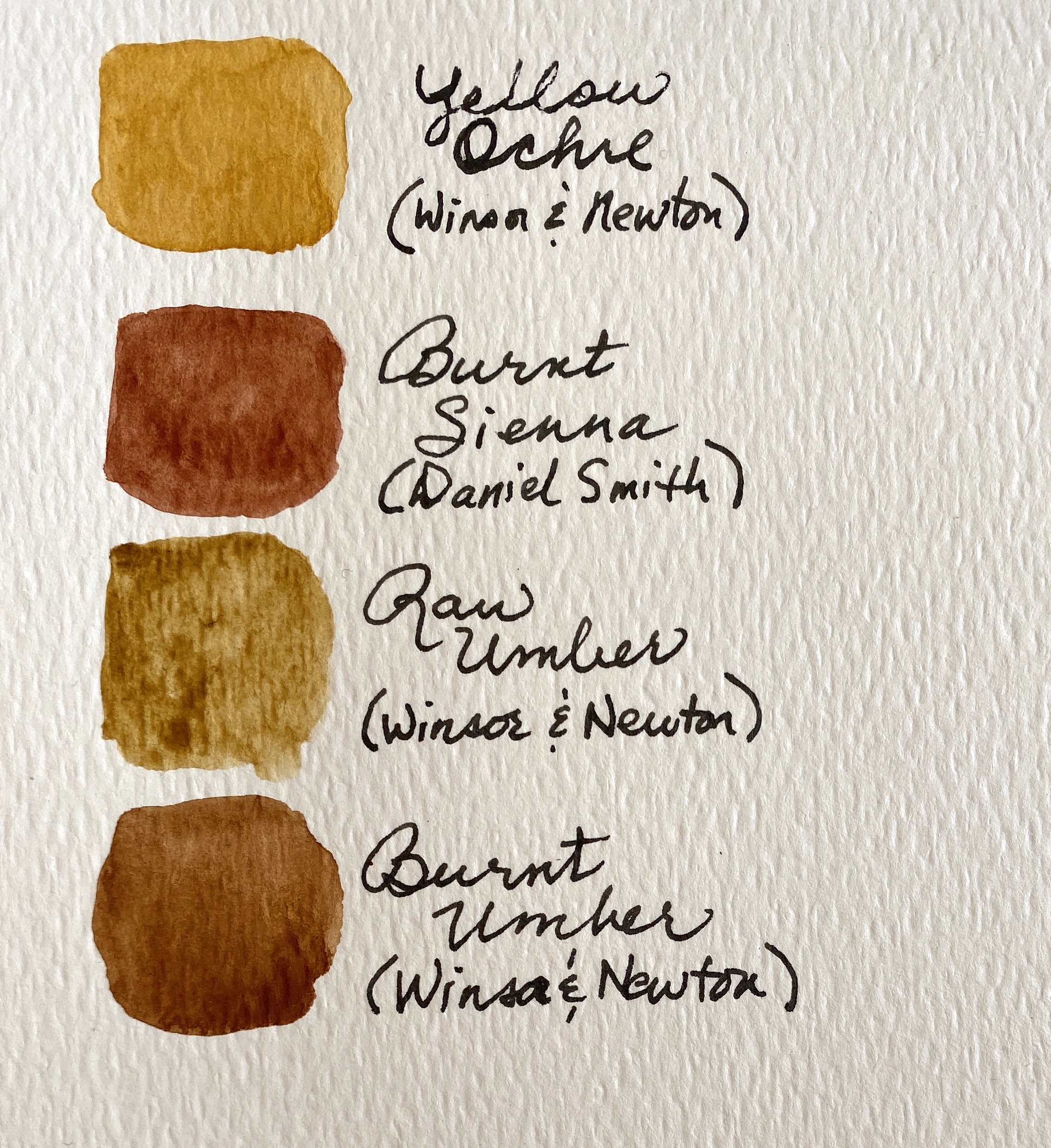
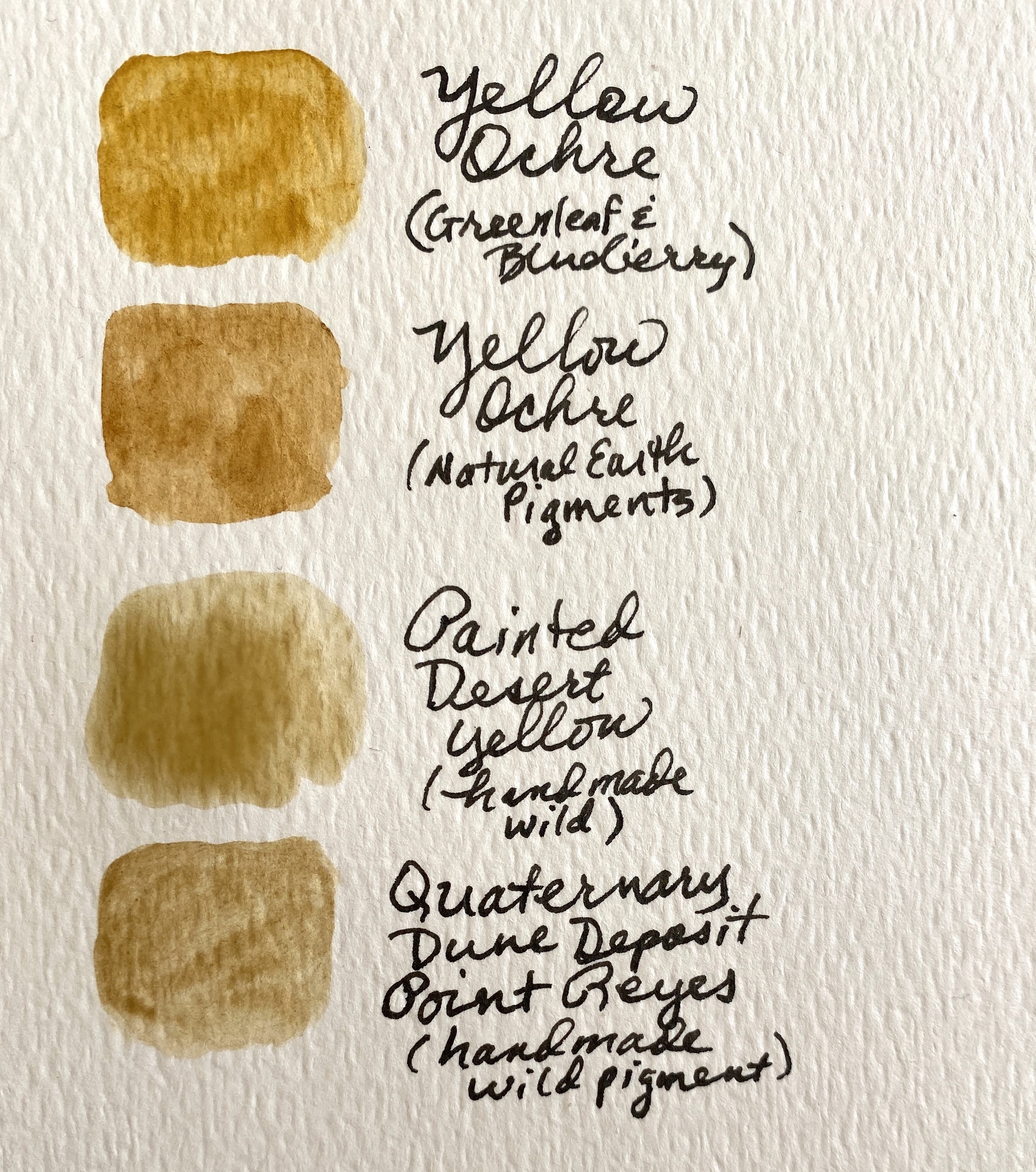
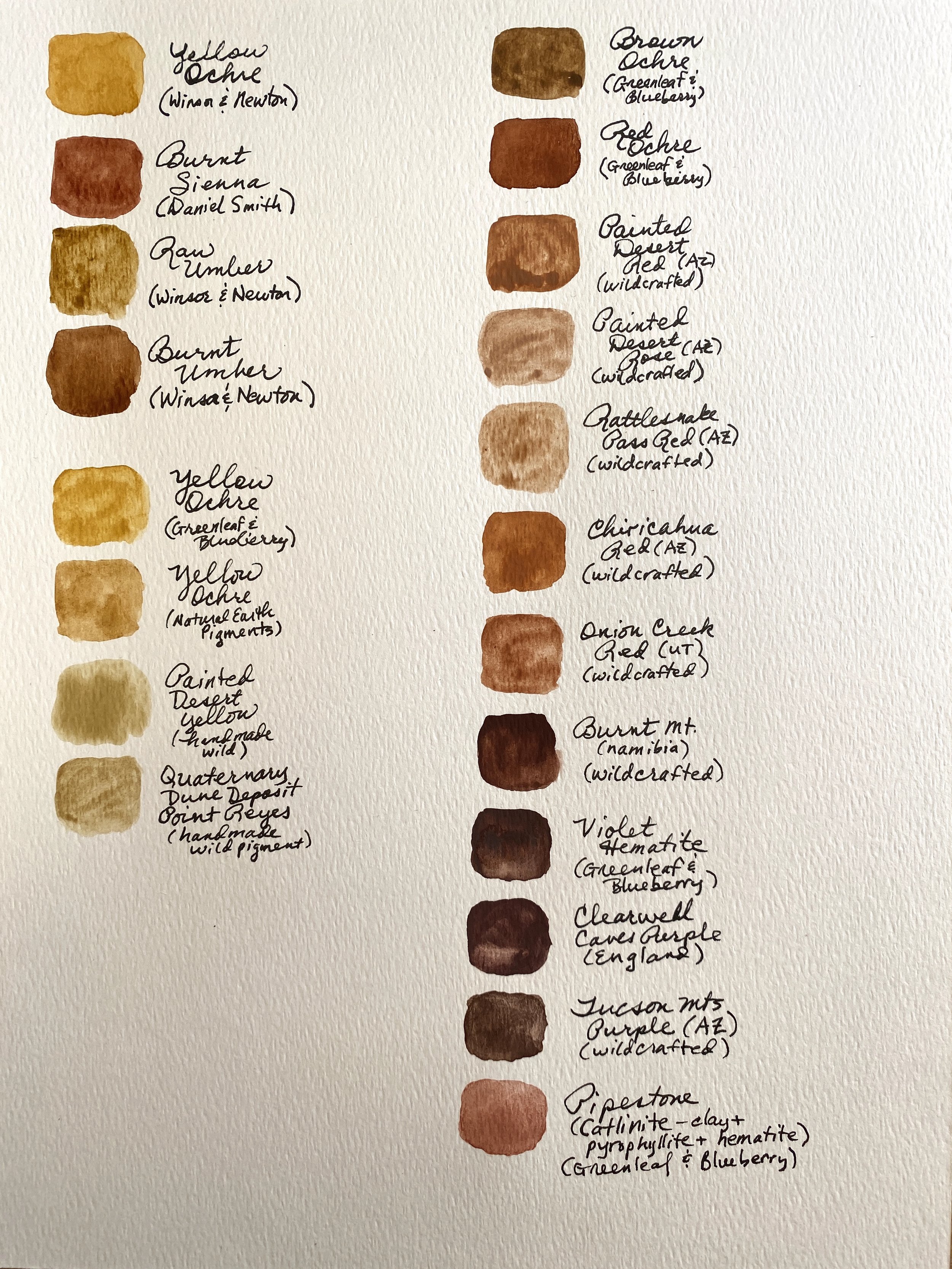
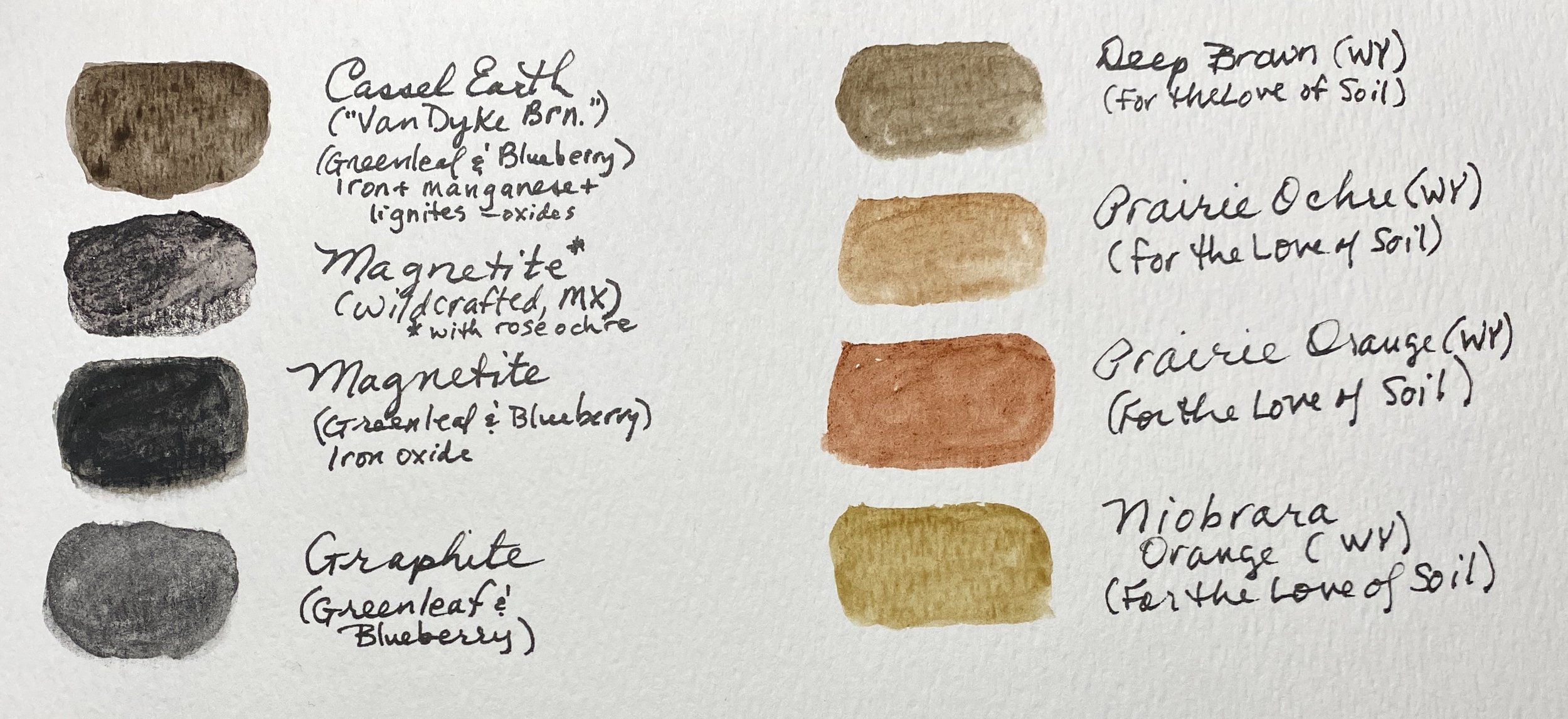
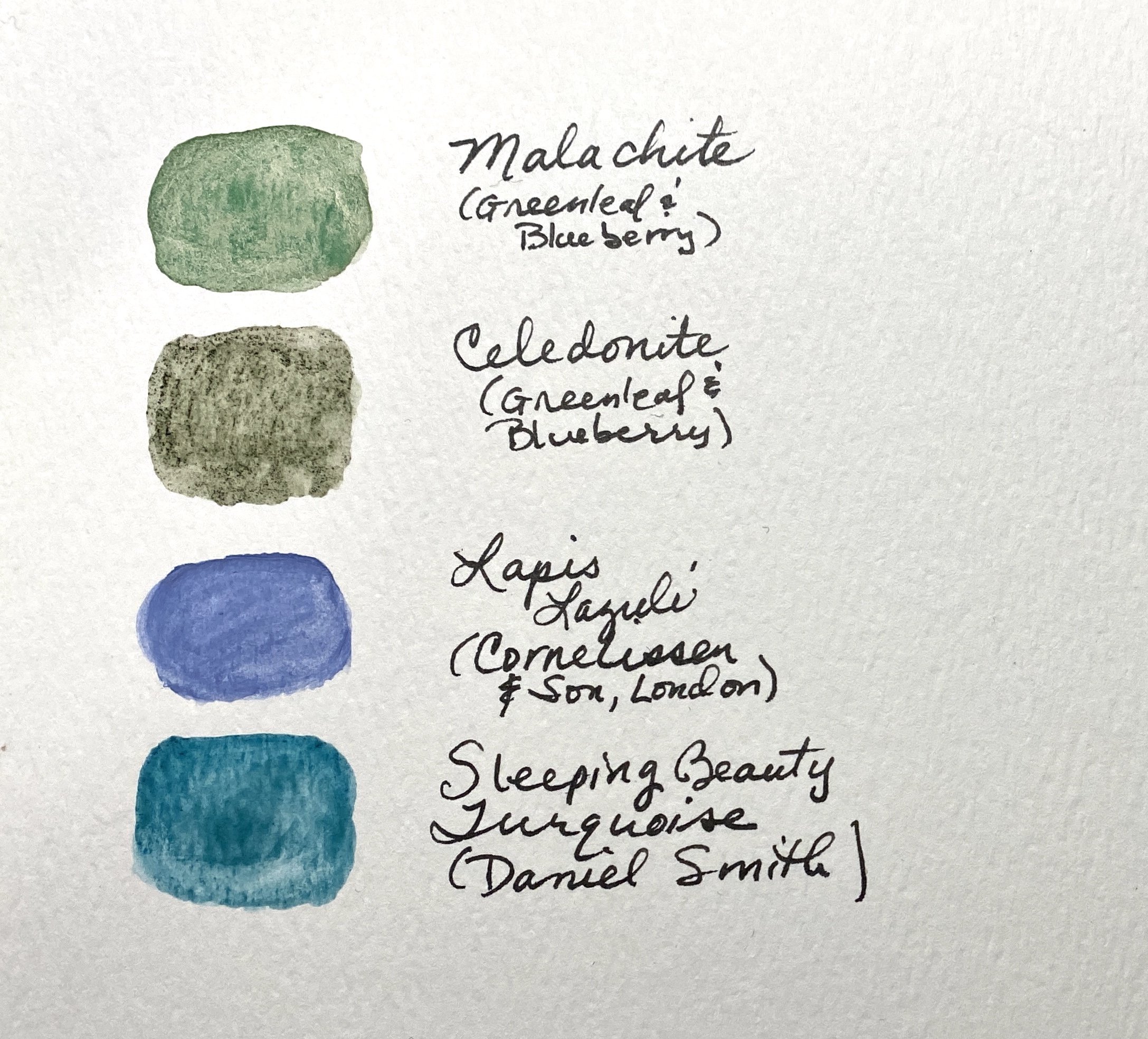
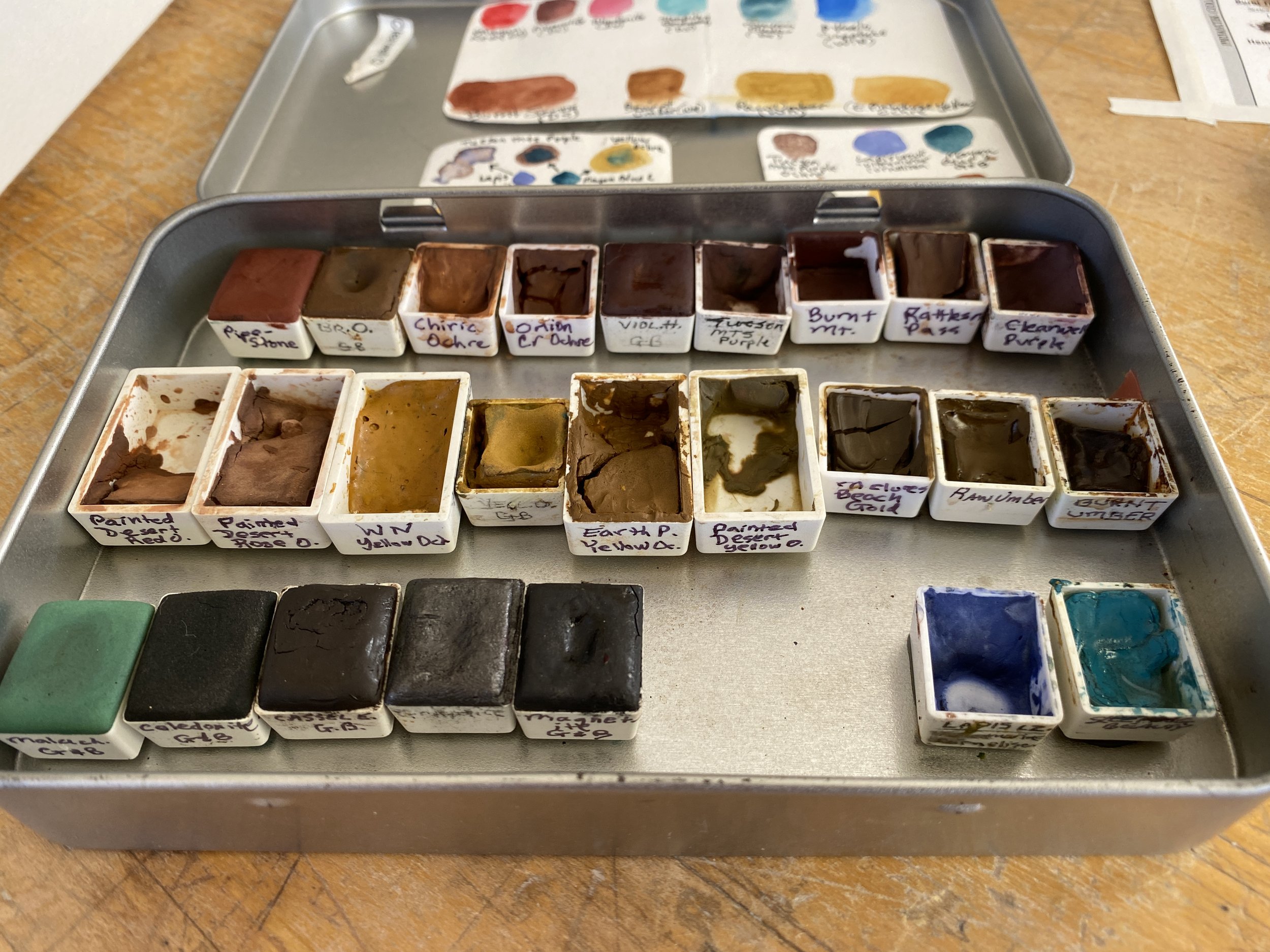
Images from Workshop Participants
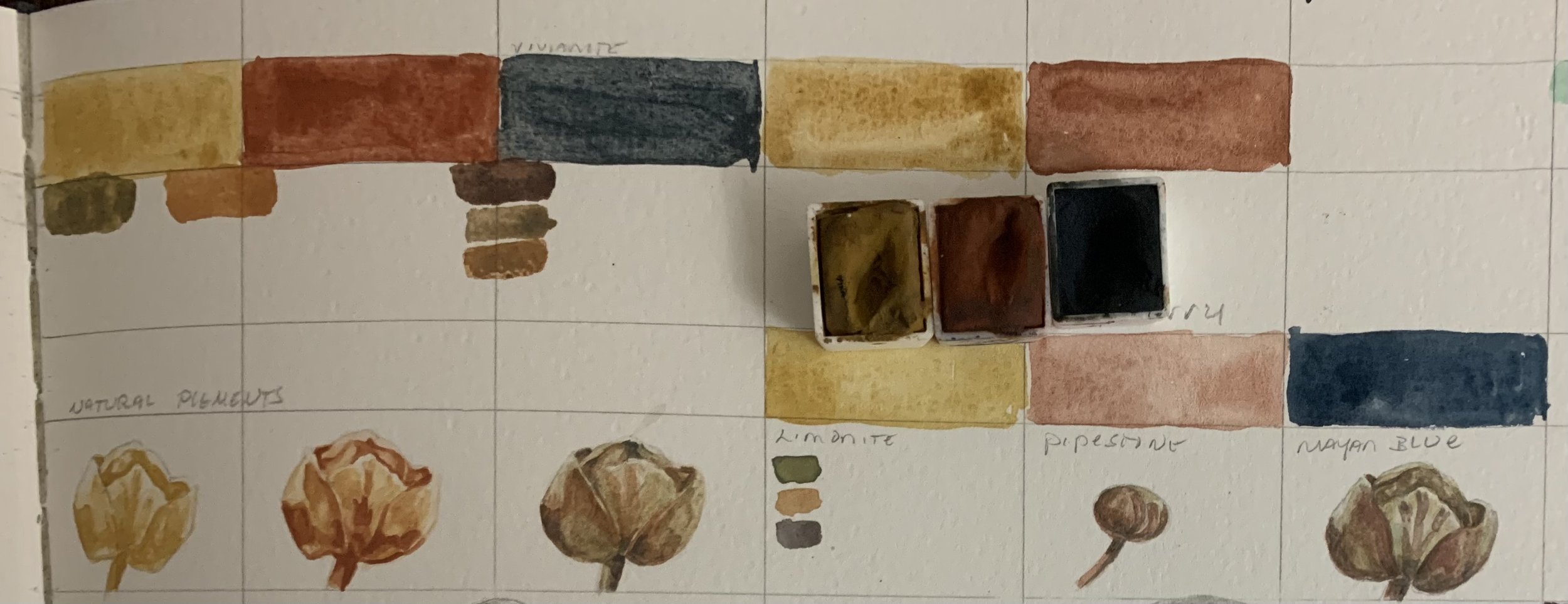
Field Arts Workshop: Elegant Ink for Field Notebooks
Join me for a celebration of the art of elegant ink in our sketchbooks. While I do love color in my journal, I also love the beauty of well-wrought pen sketches.
We’ll cover types of pens and inks (from ballpoint to fountain pens, including the pluses and minuses of the types); practice mark-making and values; and work on a couple of different types of sketches using one image to create each, so we can see how different styles of linework each produce a different “feel” on your pages.
Length: 2 hours
Images at right: Creating various “palettes” for your marks is a great exercise and very useful to keep tucked in a pocket of your journal for reference. The different types of stroke, texture, and tone are like words in a language or paint colors in a palette: you choose each for a different effect, feel, tone, or emphasis.
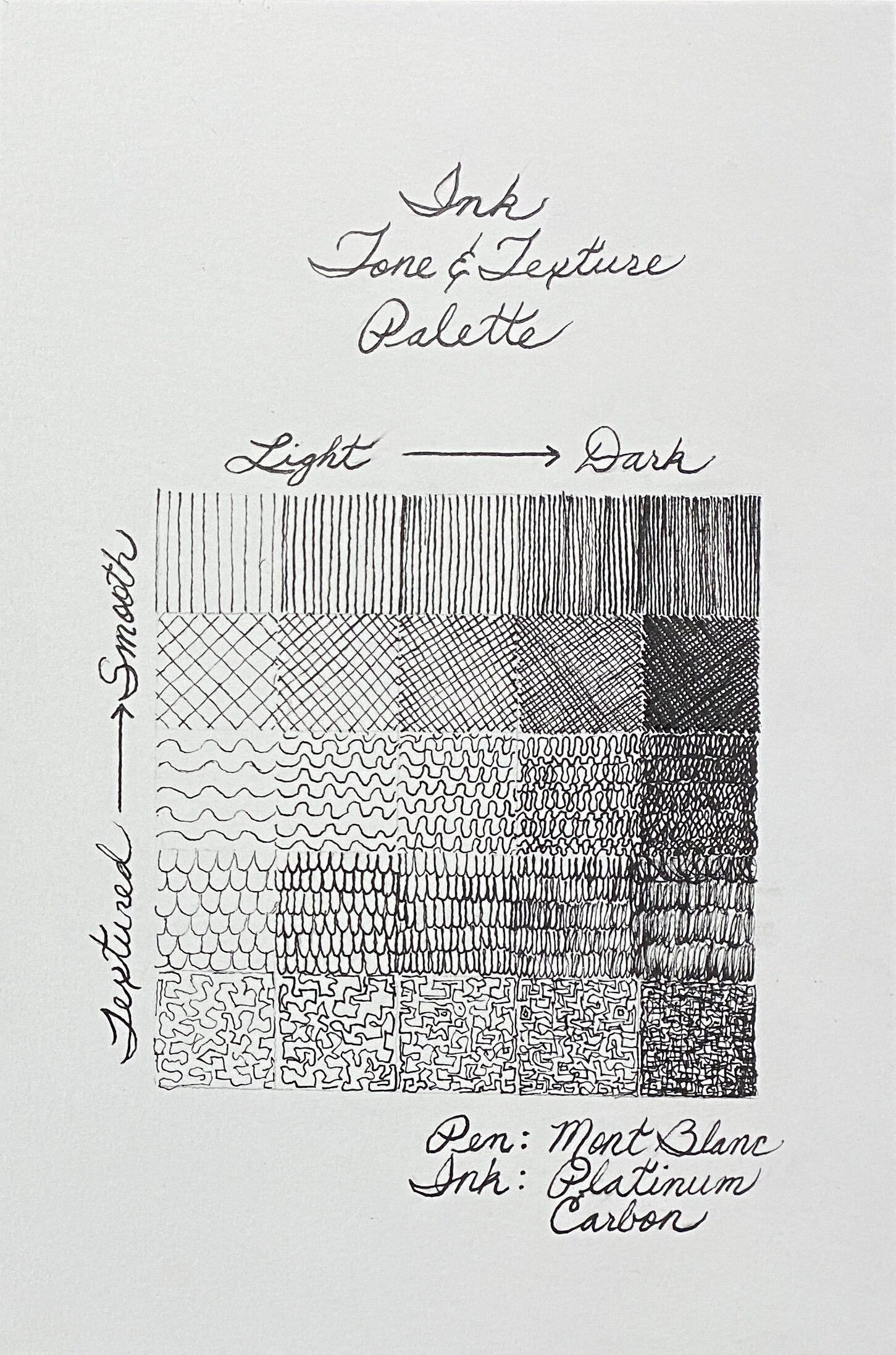

Resources from the Workshop
CHAT transcript — click > HERE <
Click image BELOW to initiate download for the workshop PDF with all the information, sample images, and links. Or, use: https://www.dropbox.com/sh/rvlzr0a9hezdgjr/AACw6pH9jwhj6sQ-rvmM_GGwa?dl=0
Bonus! I did a short video (no sound) of how to clean and refill a fountain pen:
DEMOS FROM THE WORKSHOP



